It’s up to the Doctor and Osgood to stop a war. And it’s time for Peter Capaldi to blow everyone away with the majestic tears in the eyes.
Hope you had tissues for this one.
Summary
We find human Clara stuck inside her own head (very much alive, of course). She appears to be in her own flat, but keeps seeing and hearing things that pertain to the Doctor’s current situation with Bonnie. She tries to prevent Bonnie from shooting the Doctor out of the air, and succeeds on her first try, but not on her second. Thankfully, when she pauses the playback on the television in her mind, she notices two parachutes exiting the plane as it explodes. Bonnie finds a Zygon who is still in human form, and forces him to change back so she can get the event of film and leak it to the press, hoping to cause panic. She then goes looking for the Osgood box, but finds information on Osgood’s computer that makes is clear that she won’t find it at UNIT HQ.

The Doctor and Osgood are busy trying to escape Zygons when the Doctor gets a text from Clara saying “I’m awake.” Osgood realizes that it’s the real Clara, that she’s alive and using the Zygon version of herself to get information out. They call Bonnie and Clara uses her body to wink whenever the Doctor asks relevant questions, allowing him to discover where her body is. He and Osgood grab a van and start driving to London. Bonnie goes to speak to Clara, pointing out that they can’t lie to each other, having the same pulse. She demands Clara tell the truth or be killed. She asks Clara where the Osgood box is, and Clara tells her it’s in the Black Archive. Bonnie finds out that she only needs Clara’s body imprint to get in, so she can easily get to them. But Clara promises that Bonnie will want to talk to her once she sees the box.
The pod lair is directly below the mall where the Zygon was changed back into his alien form, and the Doctor and Osgood encounter him. The Doctor tries to help, but the Zygon is devastated at what’s been done to him, insisting that he’d wanted only to live on Earth in peace. He kills himself, terrified that his existence will start a war. The Doctor and Osgood run into Kate Stewart, but the Doctor was already told that she’d been killed by Bonnie—making this one a Zygon. They head down to where the pods are, but Clara is missing, so they head to the Black Archive. On their way, Kate Stewart kills her Zygon guards, revealing that she is the real Kate Stewart; she killed the Zygon who came after her in New Mexico. The Doctor is not pleased with her inclination toward violence.

Bonnie has brought Clara’s pod to the Black Archive and pulls her out of it, going in and finding that there are in fact two Osgood boxes, one red and one blue. She presses the buttons on both and finds out that doing so leads to a second lid where each box has two more buttons, one labelled “Truth,” the other “Consequences.” The Doctor, Osgood and Kate arrive, and the Doctor reveals that each button for each box has a different purpose. For the red box, one button will gas and kill the Zygons, the other will blow up the Black Archive. For the blue box, one button will will reveal every Zygon’s true form on Earth, the other will kill them. Bonnie still wants to try her luck, insistent that she goes through with her plan. Kate is willing to respond in turn, and so the Doctor breaks it down for them—these boxes are war, distilled to its purest form. That they haven’t the faintest idea what terror their actions might bring, who will die, who witness unimaginable things. That even once someone wins, there will always be another war, and that every war ends the same way: with people eventually having to stop the fighting and talk to each other. Bonnie begins to waver, and then she realizes that the boxes don’t do anything. They were just a way for the Doctor to talk them out of fighting.
Kate points out a problem—that knowing that boxes are empty could still break down the ceasefire. The Doctor tells her that they’ve had this conversation fifteen times already, and she won’t remember a thing; the Black Archive still has the ability to wipe people’s memories. But in the end, Bonnie realizes that the Doctor hasn’t wiped hers. He claims that he wants her to remember what happened and keep the peace. Bonnie calls off the splinter sect, ending the potential war. Later, the Doctor and Clara are leaving, and the Doctor asks Osgood again—is she human or Zygon? She insists she’s just Osgood… and then another one appears. Bonnie has chosen to live out her life in Osgood’s form, so that there will always be two of them to protect the box and prevent war.
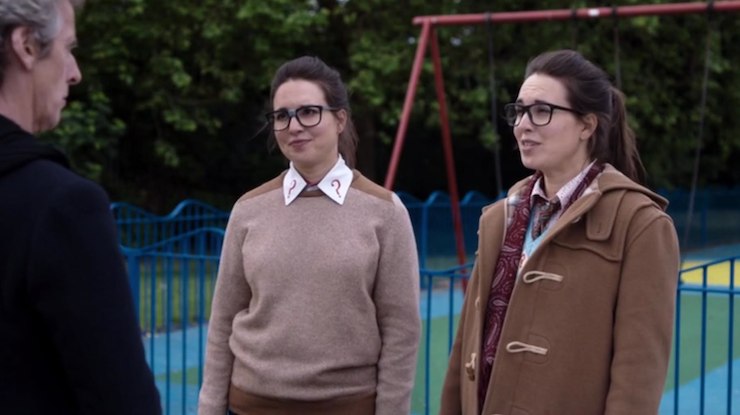
Commentary
So… that was pretty much the definition of tour de force.
We get some great stuff from Clara here, especially in her interactions with Bonnie. (Though I’m confused as to why they’d have the same pulse? Yeah, just hand-wave that one.) All the little, clever things that Clara does to get word out to the Doctor are inspired and fun. I had hoped that we’d see more of how her emotions and memories affected Bonnie and the choices that she made, but on the whole, I enjoyed watching Clara work from inside her own head. (And I also enjoyed watching Jenna Coleman get a chance to play an entirely different character.)
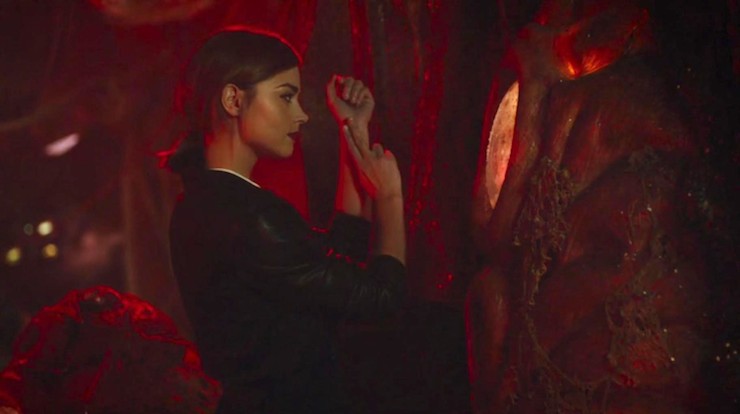
Osgood has morphed entirely from a fun side character who fans could relate to into a character with a purpose that is entirely unique and fascinating within the context of their universe. Her continued insistence that she cannot be defined as either human or Zygon is wonderful, and has the added relevance of applying to so many situations for humans as well—biracial people who are asked to specify one ethnicity over the other, gender fluid people who are constantly asked whether they are men or women. Interestingly, we now have both Osgoods and Ashildr hanging out on Earth, keeping an eye on things… we have to assume that’s going to be important going forward. It’s too bad that Osgood won’t likely be a permanent companion, though, not only because she’s a great character but because it would be great to have another companion who wasn’t completely human again.
Then we find out that Kate Stewart isn’t dead, and the Doctor asks how she survived and she says, “Five rounds rapid,” just like daddy Brigadier Lethbridge-Stewart used to do, and nothing, I’m fine, OKAY I’M CRYING, ARE YOU HAPPY?! You monsters. I mean, I get that the Doctor is upset over the violence involved, but in that particular moment it was really hard for me to care. Have I mentioned that the addition of Kate Stewart might be one of my favorite things about the Moffat era? It just means so much to have that tie to the Brig and old UNIT.
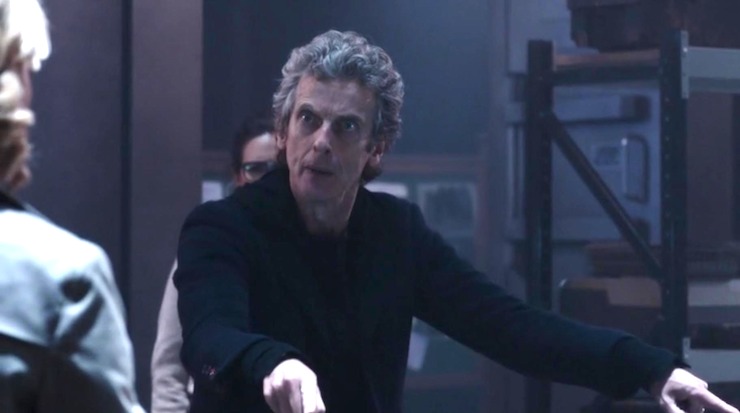
But the centerpiece is inarguably the Twelfth Doctor’s defining moment in the series up to this point, the moment that truly “makes” his Doctor, and perhaps one of the greatest scenes the character has ever been given to play, period. A treatise on war, his philosophy and purpose, every little bit of pain magnified and laid out, all to prevent people from making the same mistakes that they always do. Over a millennia of experiences the Doctor has had, every horror the Time War wrought, all the people he’s lost, and it all comes down to the moment where he can explain, with utterly clarity, that war doesn’t solve any problem. That the only thing that war does is postpone the inevitable—the point where people must sit and talk to each other. And in the interim, so much is destroyed.
Capaldi wrings this scene out like he’s a parched man searching for water, he hits every emotional note, and if you were never sold on this Doctor the way you were for previous incarnations, I dare you to deny him now. The tears, the frustration, that deep sadness that he wears so well, we can see where this Doctor came from, what he has to lose this time around. And for all that pain, he doesn’t resign himself. He still believes that people can be better. He never lets go of that belief. In this age of bitter, betrayed, angry protagonists, it means so much to see a hero who believes that the best is still possible. Who forgives and loves and takes it on himself to prevent other people from hurting. I think what the Doctor told little Danny Pink last season applies more than ever, here: Being scared is a superpower. And it’s his fear, in this moment, that ultimately saves the world.
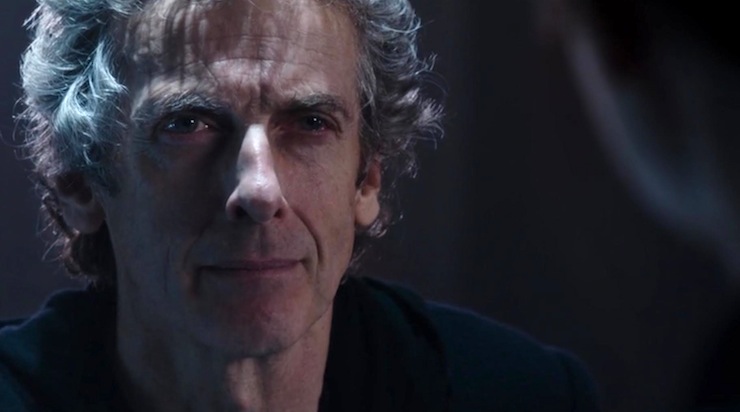
And then the episode hits you with one extra revelation—this is the fifteenth time he’s had this argument with them. He has already tried fifteen times, and he kept going because there was only one outcome allowed.
Ironically, the episode’s greatest strength also leads to its primary weakness. While the plot becomes all about big ideas, the horror of war at its most basic, we lose the Zygon narrative. The idea of a splinter sect that wants the ability to stop hiding their forms is never addressed again in the story. We don’t know why it’s so easy for Bonnie to call her people off and demand that they live peacefully. It’s an unfortunate gap that would have made an excellent story even stronger.
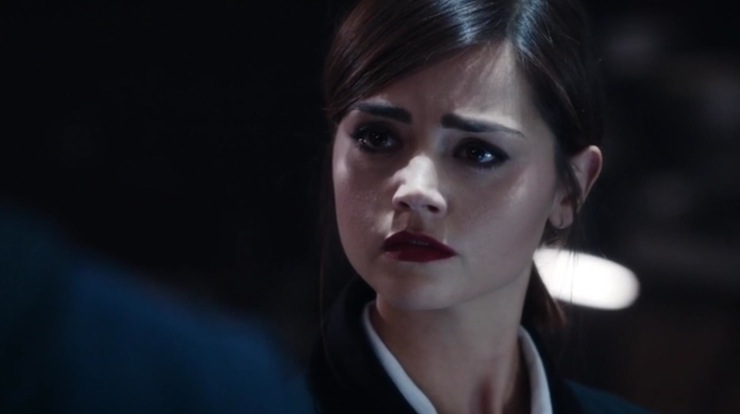
We end with Clara asking what it was like for the Doctor to think she was dead, and his response is “Longest month of my life.” When Clara insists that she was only “dead” to him for five minutes, he replies, “I’ll be the judge of time.” Since it’s Doctor Who, it’s possible that this reply might get explained away in some complex plotting mechanism, but I dearly hope it doesn’t. Because the Doctor is a Time Lord, and we know he experiences time differently from us. And that line tells us pretty much everything we need to know about what that entails.
Whovian asides and funny highlights:
- The Doctor uses a Union Jack parachute, which is a hilarious James Bond reference—007 uses such a parachute in The Spy Who Loved Me. So really, the Doctor’s comment about “camouflage” works on more than one level.
- “The Day of the Doctor” is referenced in several ways here: the appearance of the Black Archive, the use of the mind-wiping function there, and the Doctor talking about his own “button pressing” moment where he nearly destroyed Gallifrey with The Moment.
- Former companion Harry Sullivan is finally verbally acknowledged as the one who created the Zygon gas, and the Doctor calls him “the imbecile,” which is a specific reference to the Fourth Doctor story “Revenge of the Cybermen.” (Harry caused a rockslide in that serial, among other things.)
Emmet Asher-Perrin just looks at that picture of Capaldi smiling and starts to tear up. You can bug her on Twitter and Tumblr, and read more of her work here and elsewhere.










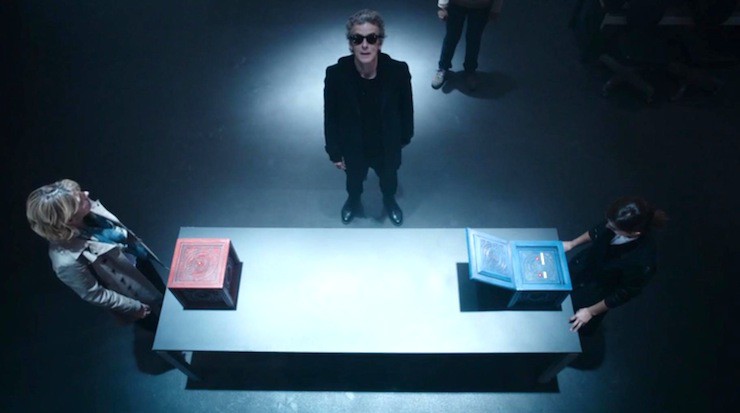
Early in last week’s episode, I got the vibe that somehow Osgood and Ashildr were linked.
When the Doctor confronted the single Osgood this week about her species, she kept insisting “I’m just Me”.
Interesting. Very very interesting…
This was definitely the strongest episode of Doctor Who so far this season. Very well presented and well acted. I very much liked the part Osgood played in the adventure, and was very satisfied with how they left the character. Capaldi definitely did a great job with his speech, and I am glad that he found a resolution that didn’t involve fighting. But, despite a few lighter moments, I find myself thinking that the show is taking itself far too seriously these days. It lacks the sense of whimsy and fun that has brought me so much enjoyment over the years.
I was waiting for The Doctor to say something along the lines of, “Humans were so willing to avoid talking to each other they invented war so they wouldn’t have to,” during his speech.
Yeah, this was a terrific one overall. It’s amazing how they’ve taken the Zygons, which I’ve always seen as kind of a joke, and turned them into something complex and powerful.
Last week, I was bothered by how easily the cease-fire seemed to break down, how it seemed to ignore what “The Day of the Doctor” had said about all the multiple layers of safeguards built into the treaty to ensure the peace. But now we got to see the details of those safeguards, and while there are still probably some holes in it, it’s nice to see they didn’t just gloss over that bit for the sake of the story, instead building on it in a very effective way.
I’m afraid I did not like the “Five rounds rapid” bit at all. The question of how Kate escaped was set up as this big deal, and the payoff was just a quote of a famous line from “The Daemons,” nothing more than a fannish Easter egg. That’s my biggest problem with Moffat’s writing — the fact that he sees fannish Easter eggs as a big deal in and of themselves, as something that should be the point of a scene rather than just an incidental aside. They really shouldn’t be. Goodness knows, I work tons of continuity references into my Star Trek fiction, but only when they contribute something to the story and make sense in context. It did not make much sense here. First off, aside from the continuity nod, there is nothing remotely impressive about “I pulled out my gun and shot her” as an explanation for her escape; as cliffhanger resolutions go, it’s staggeringly dull and anticlimactic. And second, “five rounds rapid” is not some recurring catchphrase of the Brigadier’s; he used it exactly once, in “The Daemons.” (The line did recur in “The Mysterious Planet,” but spoken by Sabalom Glitz.) In-story, there’s no logical reason why Kate would phrase her explanation in those words. So it just didn’t work.
The Doctor calling Harry Sullivan an imbecile, on the other hand, is a continuity nod that makes perfect sense in context. It’s in character for the Twelfth Doctor to be insulting and not to bother recalling people’s names, and it’s entirely fitting that he’d be very disappointed in Harry Sullivan for violating his Hippocratic Oath and developing an anti-Zygon nerve gas with a horrifically sadistic effect. So that one actually works and serves a purpose.
I watched the two episodes back to back, so might be conflating some things.
In general, great idea to follow up on the Human-Zygon peace treaty from Day of the Doctor rather than simply leaving it out there.
One thing I didn’t understand is why none of the humans criticized the Doctor for refusing to supply the anti-Zygon gas. Certainly people at UNIT know about it, and it seems to me that a natural reaction would have been to say something like “We wouldn’t have lost these men if you’d supplied us the means to reveal who’s a Zygon.” I understand why the Doctor originally would have chosen to take the gas away from UNIT, but he could have provided them a limited supply, enough to take on the splinter sect but not to wipe out every Zygon on Earth. At the very least, someone should have made that argument to him, it seems like it should have been a natural reaction from someone like Kate Stewartl.
I thought Zygon-Clara aka Bonnie’s plan to upload a video of a Zygon didn’t make sense. Most ordinary people seeing a viral video like that would assume it was a hoax simply showing some guy dressed up in a costume.
Having said that, I did like the Doctor’s speech in the Black Archive — a lot!
And I literally laughed out loud at “Five rounds rapid,” that was nice!
After the first two episodes, I hadn’t been impressed with this season. But this episode… man, what a speech, what a performance by Capaldi! I love how the Doctor isn’t above humans or zygons, as he himself caused many deaths in war, he’s not preaching, he’s trying to save people from the same pain he feels.
Loved all the Osgood bits, though… but why can’t she travel in the TARDIS? She can go on a trip, and come back to the same exact second she left… IT’S A TIME MACHINE!!!
@6: And I’m sure she’s quite aware how bad The Doctor is at getting you back when and where he’s supposed to. :)
I was amazed when I realized that the Doctor’s speech had my heart beating faster, like a good action scene should. Such a powerful scene and played to perfection by Capaldi. If you start pulling at the edges his point unravels a little, but you have to give him and the writers credit for going there at all.
The line “I’m old enough to be your Messiah!” Made me laugh out loud, but I thought about it again when the Doctor forgives Bonnie with tears in his eyes. I loved this episode a lot.
I certainly found the “Five rounds rapid” to be a better link to old Alistair Lethbridge-Stewart than the distasteful “Cyberbrig” from the exceedingly distasteful and more than a little horrifying-and-not-in-the-good-way-but-in-a-how-did-this-get-approved-way Death in Heaven. Having said that though, apart from the speech at the end, there was very little to recommend this or even justify it being a two parter. Perhaps that was also a tribute to the old UNIT era, extra padding in the story to plump out the episode count just the Pertwee era always used to have.
That speech to Kate and Bonnie is why Doctor Who is the best. It’s what the show has always been about at its heart. The Doctor finds a way that has the fewest number of people dying.
Just brilliant.
—Keith R.A. DeCandido
This was such a brilliant episode.
One thing though – neither blue button would kill the Zygons. One of them would force them to reveal their true forms, and the other would disable their ability to shapeshift, basically making them human. I thought that was important to mention…
@11/Bernice Mills: But forcing them to reveal their true forms would have triggered panic and open warfare, and the 20 million Zygons were outnumbered by the 7 billion humans, so it would’ve still most likely led to their deaths.
I still don’t get why the Doctor is so adamant that the Zygons must live on Earth, and assimilate into Earth culture, hiding their true selves, when he could EASILY help them find a new world to live on where they could be themselves. That really bugs me. It’s like he’s putting his own ideas of what things should be like ahead of the greater good.
@13/JohnstonMR: No — in “The Day of the Doctor,” it was UNIT and the Zygon leaders who negotiated the treaty terms. The Doctor(s) just temporarily wiped their memories of which side was which, so that they’d all have an incentive to make the treaty as fair as possible. He explicitly said, “Then you’re going to negotiate the most perfect treaty of all time.” He didn’t define the terms of the treaty himself, he was just the mediator.
So it was the Zygons themselves who wanted to live on Earth. They’re a refugee people, having lost their world in the Time War, and they’ve tried to conquer Earth in the past, so evidently they consider it suitable to their needs. This is where they want to be, and most of them are willing to survive by blending in. Maybe eventually humanity will be ready to accept them as they are, but it’ll take time. (I wonder if they’ll still be around a thousand years from now when the Silurians wake up. Earth may end up being quite a multispecies civilization, thanks to the Doctor’s peace negotiations.)
I may be one of the few people who noticed (which dates me rather) but when the Doctor was doing “generic game show host” during his big speech – that wasn’t a generic game show host. That was Hughie Green to the life! He was really big in the 1960s and 1970s on UK TV with shows like Opportunity Knocks (a talent show) and The Sky’s The Limit.
Two-parters usually have a strong first part and a weak second. This one is a pleasant exception. First there was the scene with the Zygon who just wanted to live his life quietly, a scene that should have been in the first episode as it is really necessary to show us that most Zygons do want peace, instead of just telling us. Then there was Clara being able to use the telepathic link. It is completely believable that with her experience, she would be able to resist better than the other victims (like how Jo Grant quickly became immune to the Master’s mind control ability), and yet her ability to use the link was weak enough that it didn’t feel like it was robbing the other victims of their agency. Instead, she had to be extremely resourceful to use the link to its full potential: once again she proves to be a great companion. And I squeed at Steward’s “five round rapid” (and the call back to that scene).
But what made the episode for me was of course the scene in the Black Archive. The presentation of war as a game is disgustingly cynical, removing all notion of honour from it; this makes a lot of sense to someone like the Doctor who has been in so many. Then there is the comparison of terrorists to capricious children. It seems naïve and patronizing to claim that even the leader hasn’t given the tiniest amount of thought to what comes after, but once again, it makes sense from his point of view. Because as he tells Bonnie, he has been in her situation many times before. He has a lot of experience – at being a capricious child. He keeps getting involved into impossible situations, and then decides what’s best for everybody. He does what he thinks is right, but in the end he’s only a mad man with a box, and he has to live with the consequences of his actions for millennia (and only his actions: “You are responsible for all the violence, all of the suffering. – No, I’m not”) He’s someone who took parts in the most terrible things and became wiser from it. And that’s why he is in a position to forgive Bonnie. She is right in that there doesn’t seem to be any escape for her, and it seems flippant of the Doctor to forgive her after all the people who died because of her. But then he explains how much they are alike. The Doctor acknowledges how similar he is to a terrorist. And that is perfectly true considering the number of genocides he has committed. Sure he always had great reasons, but terrorists also think they do to. Which is why he doesn’t want to condemn them, but to make them understand that violence is not the solution. This episode has all the nuances that were lacking from the first part; it is about protecting peace by making people actually want it. There has rarely been a more powerful speech in this show. And it’s hilarious that it took him 16 times to find the right words to stop Bonnie and Kate, but it does show that peace isn’t easy to achieve, that it is an ideal worth striving for.
The thing that really bothered me was the “Truth or Consequence” bit. Why would the terrorist cell have the same name as the words on the boxes? And what’s the relationship with the city? I was also annoyed at the Doctor’s insistence on knowing which Osgood he was talking to. I get it, he wants to know whether he’s created a hybrid because of that prophecy, but whoever she is, she is a human/Zygon hybrid anyway so the Doctor really doesn’t need to know anything . She doesn’t want to tell, and she shouldn’t have to.
@5: In this world, people would take the video at face value: “What, it’s just another alien? Thumb down.”
“Bullet between the eyes. First thing. Twelve times if necessary.
You have really thought this through, haven’t you?
I’m a big fan.”
Another vote for “great episode!”
Were my eyes deceiving me, or was that in fact a head of one of the Mire (from “The Girl Who Died”) visible in the background in the Black Archive scenes?
@17: It’s a Mire helmet, not a head, but otherwise yes.
Am I the only one who thought the “last 15 times” line was a throwaway insult/joke from the doctor? Wiping Kate doesn’t magically make all the Zygon and units members instantly forget the previous civil wars as well.